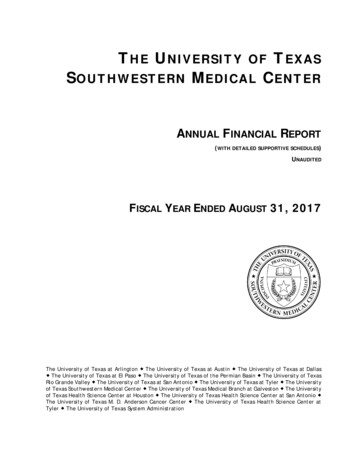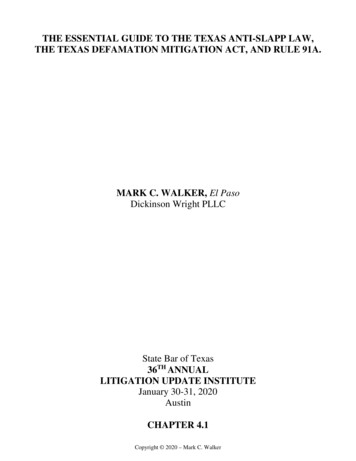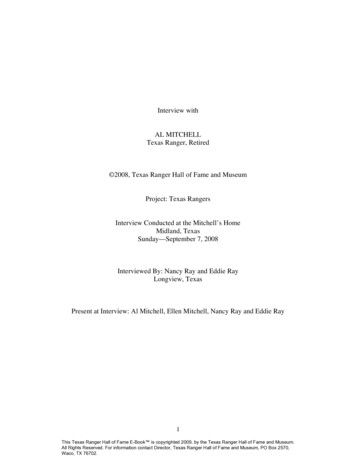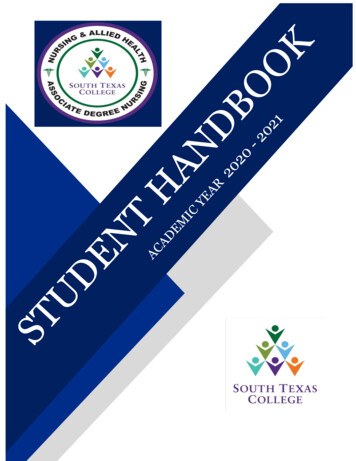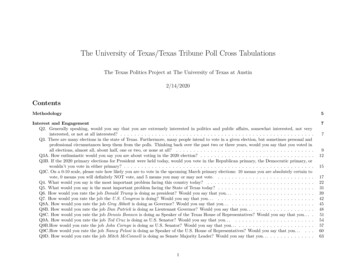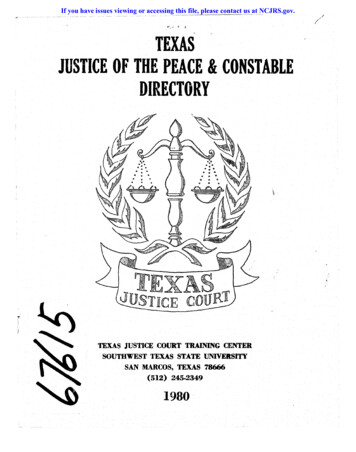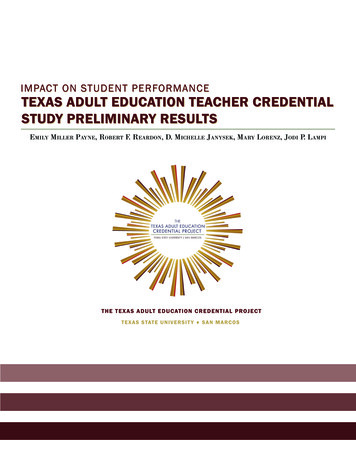
Transcription
IMPACT ON STUDENT PERFORMANCE: TEXAS ADULT EDUCATIONTEACHER CREDENTIAL STUDY PRELIMINARY RESULTSEmily Miller Payne, Robert F. Reardon, D. Michelle Janysek, Mary Lorenz, Jodi P. LampiABSTRACTThis research brief offers the results of a study of the impact of the Texas Adult Education TeacherCredential (the Credential) on student performance as measured by the TABE and BEST Plus assessments based on an analysis of three years (2010-2012) of Texas Educating Adults ManagementSystem (TEAMS) data. This initial analysis reveals three primary findings: Classes taught by teachers whohave earned the Credential have significantly more students meeting required gains, as defined by theTexas State Assessment Policy, for both TABE and BEST Plus assessments; classes taught by teacherswho are employed full-time have significantly more students meeting required gains for both TABE andBEST Plus assessments; and Credential status of adult education teachers appears to have a largerimpact on student performance than does full-time paid employment status.KEY IMPLICATIONSThree key findings of the study will be discussed in this research brief. Results indicate that (a) classestaught by teachers who have earned the Credential have significantly more students meeting requiredgains for both TABE and Best Plus assessments, (b) classes taught by teachers who are employed fulltime have significantly more students meeting required gains for both TABE and Best Plus assessments, and (c) the (moderate) relationship between Credential status and class performance ismuch larger than the (small) relationship between employment status and class performance. It isimportant to note that the statistical techniques used for these analyses cannot establish causality butdo support the notions that credentialing and the use of full-time paid teachers does improve studentoutcomes. Additional investigation and analysis will attempt to establish causality.INTRODUCTIONThis research brief shares preliminary findings from an on-going study designed to examine theoutcomes associated with earning the Texas Adult Education Teacher Credential; the primary focus is toidentify any potential impact on teachers, students, programs and policy. The researchers analyzedthree years (2010-2012) of program, teacher, and class data in the Texas Educating Adults ManagementSystem (TEAMS) housed at Texas Education Agency (TEA). The primary research question for thispreliminary study was: How does being taught by adult education teachers who have earned the TexasAdult Education Teacher Credential affect student performance?The study was conducted by the Credential staff and by Texas State University Adult Education andDevelopmental Education faculty and doctoral students. Factor variables of the dataset include:Credential status, employment status, location (GREAT Region), K-12 certification level, fiscal agencytype, degree type, and amount of staff teaching each class. This research brief addresses two of those1 Page
variables, credential status and teacher employment status. Further analysis of the dataset is underwayusing multivariate statistical analysis and path analysis to determine the impact of interactions of these,and prior mentioned variables, on each other; those results are forthcoming.BACKGROUNDQualifications for Adult Education TeachersQualifications for hiring adult basic education and GED teachers are not standardized nationally. Whenpolicy standards exist at the state level, there is great variation in the rigor and consistency amongstates (Smith and Gomez, 2011; D. Stedman, personal communication, August 10, 2010). Most statesrequire a bachelor’s degree; some states require K-12 teacher certification, and only a few states offeror require certification in adult education (Bureau of Labor Statistics, 2009; Smith and Gomez, 2011).Texas requires a four-year college degree in any discipline for teaching in a state-funded adult educationprogram accompanied by 12 hours of professional development annually. More professionaldevelopment hours are required for those who do not hold a K-12 teaching certificate and for teachersnew to adult education (Texas State Board Of Education Rule on Adult Education, 2010). Texas hasoffered an optional adult education Credential since 2004.A Brief Overview of the Texas Adult Education Teacher CredentialEach year, approximately 3 million adults enroll in adult education programs. These programs benefitadult learners by providing them with valuable labor market skills as well as two of the most basicprerequisites for postsecondary education, high school equivalency and English language literacy. Aswith K-12 and postsecondary education systems, improvements to adult education programs havefocused on establishing standards for program activities and student preparedness for employment andpostsecondary education.High quality, standards-driven programs require teachers who possess the knowledge and skills tofacilitate adult learning. Formal training and credentialing establish high standards for adult educationteachers and increase the status of adult education programs. To this end, the Texas Adult EducationCredential was developed and implemented as a state-wide adult education initiative and is the meansby which Texas adult education teachers demonstrate that they possess the knowledge and skillsnecessary to improve under-prepared adult student readiness for both college and career.The Credential emphasizes the link between theory in adult education and professional practice.Credentialed teachers move beyond simply understanding adult education theory; they work towardmastering their practice by completing high quality professional development, implementing what theyhave learned in their classrooms, and engaging in critical self-evaluation in which they analyze bothstudent and instructional outcomes.The Texas Adult Education Credential was one of the first teacher credentialing systems in the nationand has provided guidance to other states as they begin to develop their own systems for teachercredentialing. Further, Texas has been actively involved at the national level in the work related to bothnational adult education standards and a national adult education credential and is one of the few statesto offer an additional credential for administrators of adult education programs.2 Page
RESEARCH DESIGNTeacher training has long been considered to be a significant element of quality education programs.However, research studies often lack sufficient rigor to demonstrate the effect of teacher training onstudent achievement (Borko, 2004; Fuller, 2010; Supoviz, 2001). Further, research on instructionalstrategies for teaching adult learners in adult basic education is virtually non-existent (Chisman, 2011;Hector-Mason et al., 2009). This study begins to address this paucity of research and is intended to leadto more in depth analyses in subsequent studies.The goal of this study is to determine whether teachers of adult students who earned the Texas AdultEducation Teacher Credential (the Credential) show higher performance than non-credentialedteachers, as measured by the percentage of required student gains 1 on the TABE Language Arts, TABE Reading, TABE Math, Best Plus Oral, and BEST Literacy .The dataset used was requested through a Public Information Request (PIR) submitted to the TexasEducation Agency (TEA). The data were mined from the Texas Educating Adults Management System(TEAMS). These data, from years 2010, 2011, and 2012, provide records for every adult education classtaught and entered in the accountability system and include general demographic data, employmentdata, qualifications, and overall class performance data. In the case of this study, the class performancedata, which are the percentage of student gains for each of the tests mentioned, serve as a teacherperformance measure to determine the outcome of earning the Credential. Although the datasetincluded several variables 2, for the purpose of this initial study the researchers examined only theeffects of the Credential and of employment status on the percentage of students meeting theirrequired gains.After combining all three years of data, the dataset was filtered to contain only those teachers who hadearned the Credential (called “Completed” in Table 1) and those who had never been exposed to thecredentialing process (called “None” in Table 1); then, the researchers looked at all of the classes taughtby these teachers. Since teachers typically teach multiple classes each term, one teacher might havemultiple class records in the dataset. However, these classes are unique; none are duplicated nor dothey contain the same group of students. Thus, the teacher performance outcome is solely based on thepercentage of students meeting their required gains by class.The dataset included a total of 18,916 classes over the three-year period. Table 1 describes some of thedemographic characteristics of the dataset; however, to understand the difference between teacherperformance of those with and without the Credential, the researchers did not include those classestaught by teachers who had been exposed to the Credential process, but not yet earned (“new” and“initiated”) the Credential, to prevent as much bias as possible.1Students are given a baseline assessment prior to instruction, and after instruction, if they score at one more levelsabove their baseline assessment, they are considered as having reached gains as required by the state through NRS.2Factor variables of the dataset include: credential status, employment status, location (GREAT Region), K-12certification level, fiscal agency type, degree type, and amount of staff teaching each class.3 Page
Table 1Teacher Credential and Employment StatusCredential StatusNoneCompletedInitiatedNewEmployment StatusPaid/full 00.0RESULTSIn looking at the impact of the variables, Credential Status and Employment Status appear, at firstglance, to have the largest impact on teacher performance. Credential Status, by far, had the mostsignificant impact on the percentage of students demonstrating the required gains. This impact wasmeasured by an independent samples t-test, which compares the means of two groups. Results aredisplayed in Table 2.Table 2Percent Difference in Gain for Credential TeachersOutcome Measure% Student gains in TABE Reading% Student gains in TABE Language% Student gains in TABE Math% Student gains in BEST Plus Oral% Student gains in BEST Literacy Difference inrequired 78172.68345231.990235.957p .001.01 .001.08 .001d0.090.390.110.230.59What this says, by every measure, is that the teachers with the Credential had a higher percentage ofstudents demonstrating the required gains; see Figure 1. For example, the average percentage ofstudents meeting the required gains in TABE Reading is 9.1% higher in classes containing a teacher withthe Credential. Statistically, the difference is significant for all measures except BEST Plus Oral.4 Page
Percent GainImpact of Credentialing on% of Students Meeting Required Gains1009080706050403020100Not CredentialedCredentialed% Student% Student% Student% Student% Studentgains in TABE gains in TABE gains in TABE gains in BEST gains in BESTReadingLanguageMathPlus OralLiteracyPercent Gain by Assessment MeasureFigure 1. Mean difference in required gains. Statistically significant differences were found for allmeasures except the BEST Plus Oral examination.Likewise, employment status appears to have a strong relationship to these outcome measures. In orderto examine the impact of Employment Status on the outcome variables, the team conducted an Analysisof Variance (ANOVA) on the data. ANOVA looks at the variance within each category and the differencein means between the categories (Full-time, Part-time, and Volunteer), basically challenging thehypothesis that there is even a difference within or between groups. A test statistic, F, is calculated andused to determine if there is a statistically significant difference in the means of the categories. With thisdataset, we found F to be significant, as measured by p .05, in all but one case; see Table 3.As shown in Figure 2, full-time teachers showed significantly higher percentages of studentsdemonstrating required gains in all measures except BEST Literacy . However, the effect size of thisvariable is very small since in all cases it explains less than 1% of the variation in the outcome variables(η2 .01). This means that, although significant, the difference has little practical use.5 Page
Table 3Differences Based on Teacher Employment StatusSum ofdfMeanSquares% Student gains inTABE Reading% Student gains inTABE Language% Student gains inTABE Math% Student gains inBEST Plus Oral% Student gains inBEST Literacy Between Groups211454.085Within 205.09726102.548Within 838.70926919.354Within 94.47921047.240Within 1398.3702699.185Within Between GroupsBetween GroupsBetween Groupsηp2Square22908.170Between GroupsF15.076 .001.0039.112 .001.00210.019 .001.0023.160.042.00051.196.303.0002Percent GainRelation of Employment Status to% of Students Meeting Required -timeVolunteer% Studentgains in TABEReading% Studentgains in TABELanguage% Studentgains in TABEMath% Studentgains in BESTPlus Oral% Studentgains in BESTLiteracyPercent Gain by Assessment MeasureFigure 2. Variance of student gains between employment statuses. Results suggest that students inclasses taught by full-time teachers show significantly higher gains.6 Page
Through further investigation using multivariate statistical analysis and path analysis, the interactionsbetween variables will be explored; however, given these initial findings, these researchers note that themost significant predictive variable so far is the Credential status of the teacher.CONCLUSIONSAdult education students in classes taught by teachers who are employed full-time perform significantlybetter than students taught by teachers who are employed part-time as evidenced by gain scores onboth the TABE and BEST Plus assessments. Texas maintains a primarily part-time adult educationteacher workforce. Only 9.8% of adult education teachers in Texas in 2007-2008 were employed fulltime; slightly more than 90% were part-time (Texas Workforce Investment Council, 2010). Most parttime teachers are paid at an hourly rate and earn few or no benefits (Bureau of Labor Statistics, 2009).Fiscal constraints are often cited as the primary barrier to employing a significant number of full-timeteaching staff; however, this research suggests that the benefits of moving to a larger portion of fulltime teachers as a means of increasing program performance gains may invalidate the tradition ofemploying a part-time adult education teacher workforce. The recommendation from this finding is tofurther strengthen and professionalize the field of adult education by encouraging the development of afull-time workforce.Adult education students in classes taught by teachers who have earned the Texas Adult EducationTeacher Credential (the Credential) perform significantly better than students in classes taught by nonCredentialed teachers as evidenced by gain scores on both the TABE and BEST Plus assessments. Thisfinding may be explained by several factors that are supported both in the TEAMS data and theliterature (Metiri, 2010; Scholastic, 2007; Smith and Hofer, 2002; Yoon et al., 2007). The process ofearning the Credential engages teachers in learning, implementing, and evaluating new knowledge andskills with more intensity than simply attending the required hours of professional development.Therefore, the recommendation from this finding is that teachers should be encouraged to tailor theprofessional development they choose to attend to meet the needs of their students and, through theCredential process, learn the valuable and replicable skills of implementing, evaluating, and reflecting asa critical part of their ongoing professional development.This study is on-going; an analysis of the dataset is underway using multivariate statistical analysis andpath analysis to determine the impact of interactions of these, and prior mentioned variables, on eachother; those results are forthcoming.7 Page
REFERENCESBorko, H. (2004). Professional development and teacher learning: Mapping the terrain. EducationalResearcher, 33, (8), 3–15.Bureau of Labor Statistics. (2009). Teachers—Adult literacy and remedial education. OccupationalOutlook Handbook, 2010-11 Edition. Retrieved from http://www.bls.gov/oco/ocos289.htmChisman, F. (2011). Closing the gap: The challenge of certification and credentialing in adult education.Council for Advancement of Adult Literacy. Retrieved September 16, 2012 fromhttp://www.caaluse.org/Closing.pdfFuller, E. (2010). Study on the distribution of teacher quality in Texas schools. The Association of TexasProfessional Educators. Retrieved from http://www.atpe.org.Metiri Group. (2010). Professional Development: Ensuring a Return on Your Investment. INTEL.Scholastic Research and Evaluation Department (2007). Scholastic RED: High-quality professionaldevelopment. Scholastic, # 139050.Smith, C., & Gomez, R. (2011). Certifying adult education staff and faculty. New York, NY: Council forAdvancement of Adult Literacy.Smith, C., & Hofer, J. (2002). Pathways to change: A Summary of findings from NCSALL's staffdevelopment study. - Focus on Basics 5.Supovitz, J.A. (2001). Translating teaching practice into improved student performance. In S. H.Fuhrman (Ed.), From the capitol to the classroom: Standards-based reform in the states. 100thYearbook of National Society for the Study of Education (Part II) (pp. 81-98). Chicago, IL:University of Chicago Pres.Texas State Board of Education. (2010). Chapter 89. Adaptations for special populationsSubchapter B. Adult basic and secondary education. Retrieved r089/ch089b.htmlU.S. Department of Education, Division of Adult Education and Literacy, American Institutes forResearch. (2012). National reporting system changes for PY 2012. Retrieved spxYoon, K.S., Duncan, T., Lee, S.W., Scarloss, B., & Shapley, K.L. (2007). Reviewing the evidence on howteacher professional development affects student achievement (Issues and Answers Report, RELNo. 033).Washington DC: U.S. Department of Education Institute of Education Sciences NationalCenter for Education Evaluation and Regional Assistance, Regional Education LaboratorySouthwest.8 Page
ABOUT THE AUTHORSEmily Miller Payne, Ed.D., Associate Professor at Texas State UniversityRobert F. Reardon, Ph.D., Associate Professor at Texas State UniversityD. Michelle Janysek, Ph.D., Grant Director at Texas State UniversityMary Lorenz, M.Ed., Grant Coordinator at Texas State UniversityJodi P. Lampi, Doctoral Research Assistant at Texas State University9 Page
THET E X A S A D U LT E D U C AT I O NCREDENTIAL PROJECTCONTACT INFORMATIONTEXAS STATE UNIVERSITYTHE EDUCATION INSTITUTE601 UNIVERSITY DRIVESAN MARCOS, TEXAS 78666PHONE: 1-866-798-9767FAX: 1-512-245-8151E-MAIL: edu/credential/
TEACHER CREDENTIAL STUDY PRELIMINARY RESULTS Emily Miller Payne, Robert F. Reardon, D. Michelle Janysek, Mary Lorenz, Jodi P. Lampi . ABSTRACT . This research brief offers the results of a study of the impact of the Texas Adult Education Teacher Credential (the Credential) on student performance as measured by the TABE and BEST Plus



